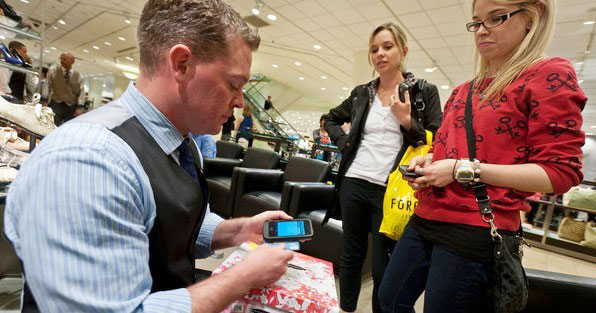Shopper receipts join paperless age
 |
|
A salesman at a Nordstrom store in Seattle ringing up a sale using a custom iPod Touch.[Photo/The New York Times] |
At an Old Navy store in Manhattan the other day, Fabienne Michel made a routine purchase of khaki shorts. But she left the store without something equally routine: her receipt.
The sales clerk had sent it to Ms. Michel by e-mail. "It's easier," said Ms. Michel, a 30-year-old nurse. "You can reprint it, save it, make folders in your e-mail."
To the rubbish pile that the Internet is creating, alongside the road maps, newspapers and music CDs, add one more artifact of consumer life, the paper receipt.
Major retailers, including Whole Foods Market, Nordstrom, Gap Inc. (which owns Old Navy and Banana Republic), Anthropologie, Patagonia, Sears and Kmart, have begun offering electronic versions of receipts, either e-mailed or uploaded to password-protected Web sites. And more and more customers, the retailers report, are opting for paperless.
"As consumers, we're changing the way we shop," said Jennifer Miles, who oversees retail systems at VeriFone, which makes checkout technology. "Customers are starting to want electronic receipts."
Many people like keeping searchable records on a computer - e-receipts come in handy during tax season, make some returns a snap and are a tidy addition to the e-purchases already stored on countless hard drives. Others see the paper versions as an anachronism, wasteful of resources and as irrelevant as printed bank statements and mutual fund reports.
And face it, paper receipts can be annoyances, burrowing into the bottoms of purses, getting lost in glove compartments or fattening up wallets - only to be pulled out and puzzled over long after their usefulness has expired.
"I throw them out," said Francesca Joseph, 29, who was shopping with Ms. Michel at the Old Navy store.
Retailers first considered e-receipts in the late 1990s, but the dot-com crash stopped most efforts, said Birame N. Sock, who runs an e-receipt company.
In 2005, Apple introduced electronic receipts at its stylish retail stores. More mainstream retailers found the checkout system difficult to replicate and, Ms. Miles said, worried that most shoppers were not quite ready for such a technological leap.
Now, though, the rush to imitate Apple's success is in full force, and paperless receipts have become a rite of passage for retailers trying to integrate the digital experience into their brick and mortar stores.
Ms. Sock said that once cellphones were widely used for payments, as with Google Wallet and other efforts, e-receipts would become standard. "A lot of these retailers are looking into mobile payments, and with mobile payments, you have to talk about the digital receipt," she said.
This year, Nordstrom introduced devices in many of its stores so roving clerks could check out shoppers on the spot. The devices can print receipts via wireless Internet when a customer asks, but the goal is to provide digital receipts.
"As the technology has started to evolve, we saw the opportunity to create a better experience for the customer, wherever they are in a store," said Jamie Nordstrom, president of Nordstrom's direct-sales division. "A customer's in a dressing room, they try on a bunch of things, they say, 'I want to buy this and that.' Now, we've got to take them out of the dressing room, wrap all that stuff at the wrap desk, use the cash register somewhere else."
Mr. Nordstrom said Nordstrom was also thinking about ways to make its e-receipts more appealing, perhaps by adding a picture of the item to the receipt so a shopper could post it to a Facebook wall.
Beyond the cost savings and environmental benefit (an estimated 9.6 million trees are cut each year for receipts in the United States, according to allEtronic, a digital receipt company), the e-receipts present marketing opportunities for retailers. Gap, Nordstrom and many other stores, for example, add the customer's e-mail address to a mailing list for follow-up offers.
That marketing potential is a drawback to some customers, said Robert Cohen, vice president of retail at Patagonia, which began offering e-receipts nine months ago. "People are very protective of their e-mail in-box," he said, so only about one-third of Patagonia's customers choose an electronic receipt.
Ms. Sock's service, MyReceipts, tries to sidestep e-mail objections by offering other electronic delivery options. The company is working with retailers like Whole Foods to upload purchase information to a password-protected site. Customers can search their receipts and soon, Ms. Sock said, review tallies of how much they spend on ice cream or shampoo.
All that data helps the retailers, too, who can send customers coupons based on the purchases history. Ms. Sock said retailers would see only a customer ID number, not personal information, unless the shopper elected to share personal information.
As paper receipts disintegrate, some people are a bit wistful.
Chris Otto runs a Web site called Papergreat, which analyzes abandoned bits of paper including old receipts, like a 1907 receipt from L.B. Hantz, a repairman in York, Pa., that included detailed drawings of a furnace and a stove.
"It's going to make it interesting for future historians," said Mr. Otto, who has kept the receipt for the first meal he bought the woman who is now his wife - a hot dog at a Sheetz convenience store. "They're going to have to be more into the computer forensics things if they want to find out what people spent money on, and how they lived."
Jesse Billin could not care less about such nostalgia. An entrepreneur in Chocorua, N.H., Mr. Billin said he was eager for the day when all receipts were digital. "I don't think I've ever held on to a receipt thinking, 'That was a really great pair of chinos. I want to remember those babies forever,' " he said.
















